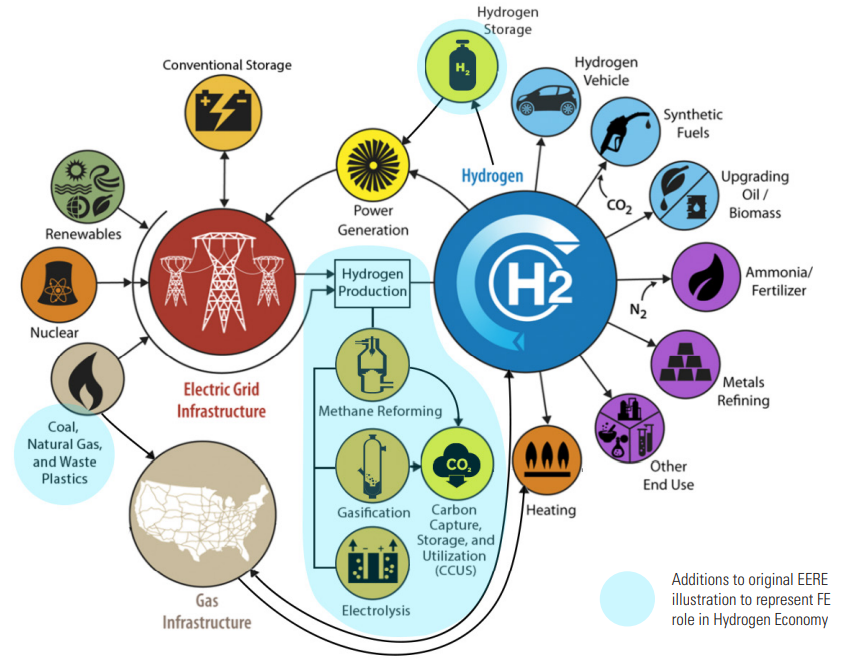
potential integration of hydrogen into the fossil fuel economy
Source: US Department of Energy, Hydrogen Strategy: Enabling a Low-Carbon Economy (Figure 1)

potential integration of hydrogen into the fossil fuel economy
Source: US Department of Energy, Hydrogen Strategy: Enabling a Low-Carbon Economy (Figure 1)
The Virginia Clean Energy Act, passed by the General Assembly in 2020, mandated that Dominion Energy provide carbon-neutral electricity by 2045 and Appalachian Power by 2050. That mandate did not require the utilities to abandon their investment in power plants fueled by natural gas, or guarantee that the pipelines that transport natural gas would become worthless.
Hydrogen has high potential to replace natural gas in industrial processes and transportation.
Natural gas molecules such as methane (CH4) can be split to create hydrogen plus elemental carbon or carbon dioxide. If carbon dioxide is released into the atmosphere, the hydrogen would be labelled as "gray." If the Co(sub>2 is captured and sequestered, the hydrogen would be "blue."
Water molecules (H2o) can be converted via electrolysis into hydrogen and oxygen. Depending upon the source of the energy used to power the electrolysis, "green" hydrogen can be produced without increasing greenhouse gases that increase global warming. If nuclear energy powers the splitting of water molecules, the resulting green hydrogen product could be labelled as "pink" hydrogen. Similarly, hydrogen created using solar power could be labelled as "yellow."
Gasification of coal/lignite produces "brown" or "black" hydrogen, reflecting its relatively high creation of greenhouse gas emissions. There is even a "turquoise" hydrogen, created by methane pyrolysis with a byproduct of solid carbon.
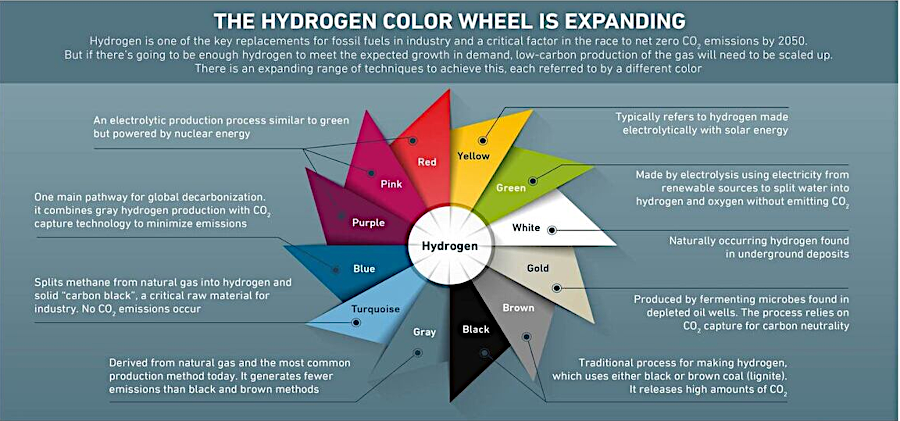
hydrogen can be produced by multiple methods
Source: Misubishi Heavy Industries Group, The colors of hydrogen: Expanding ways of decarbonization
"White" or "geologic" hydrogen is H2 gas which can be extracted by drilling, comparable to natural gas or oil. Geologic hydrogen is created by serpentinization, a natural process, at depths where olivine and other iron-rich minerals are heated to 200°C. Oxygen atoms are split from water molecules and incorporated into iron oxide (essentially rusting of iron underground), freeing the hydrogen atoms to combine with each other.
Some geologic hydrogen is created when radioactive elements in the crust decay, emitting particles that split water molecule. Hydrogen generated at subduction zones can combine with carbon to create methane, feeding the deep subsurface biosphere.
The economic potential of white/geologic hydrogen was recognized after a water well was drilled in Mali in 1987. A driller smoking a cigarette leaned over the well and triggered an explosion. The gas coming out of the well was 98% hydrogen, and has been utilized to provide power in the isolated village.
A band of iron-rich mantle rocks lies off the East Coast about 10 kilometers beneath the seabed. If geologic hydrogen is trapped within those rocks, it could be accessed by offshore drilling technology. In theory, fracking techniques could be used to inject water to stimulate hydrogen production. If carbon dioxide was dissolved into the injected water, it could react with magnesium and calcium atoms and be sequestered as limestone/dolomite at the same time hydrogen was extracted.
The first hydrogen well in the United States was drilled in 2019 into a band of iron-rich mantle rocks near the surface. By the year 2100, geologic hydrogen potentially could meet 50% of the demand for green hydrogen.
By 2050, hydrogen could provide the 20% of energy requirements that will not be met from electricity generated by renewable resources. Transport of hydrogen through pipelines will be rare. Assuming the world transitions to carbon-free energy, the infrastructure used today to provide natural gas to buildings will be abandoned.1
Source: Natural Hydrogen Energy LLC
In 2021, Lazard calculated that a gas peaking plant could generate electricity over its lifetime, the Levelized Cost of Energy (LCOE), for $55-74 per megawatt-hour. Using blue hydrogen would raise the cost to $89 per megawatt-hour. Using green hydrogen would increase the cost further to a projected $129 per megawatt-hour, exceeding even the cost of the Coastal Virginia Offshore Wind project at $87 per megawatt-hour.2
In 2020, Mitsubishi Power Americas announced plans to build three natural gas power plants designed to switch to hydrogen, when that fuel became available. One of the plants was planned for the 1,600 megawatt Chickahominy Power Station in Charles City County, which anticipated using natural gas as its initial fuel. However, plans for that facility were cancelled in 2022.3

demand for hydrogen in 2035 was predicted to be concentrated in Northern Virginia and Hampton Roads
Source: US Department of Energy, National Renewable Energy Laboratory (NREL), Hydrogen Demand and Resource Analysis
After passage of the 2021 Bipartisan Infrastructure Law, the Federal government planned to create regional clean hydrogen hubs (H2Hubs) to learn how to reliably and consistently produce, store, and transport large volumes of hydrogen at low cost. The hubs had to use "clean hydrogen," defined as hydrogen produced with a carbon intensity equal to or less than 2 kilograms of carbon dioxide-equivalent (2kg CO2e/kg H2) in order to earn 75 cents per kilogram under the Inflation Reduction Act's "45V" tax credit. However, the strongest economic incentive was the potential to earn $3 per kilogram for hydrogen produced with less than 0.45 kilograms of carbon dioxide equivalent.
Through the Virginia Tech Corporate Research Center, Virginia Tech became a member of the Mid-Atlantic Clean Hydrogen Hub (MACH2) coalition, which focused on using hydrogen as a fuel for regional industries in Southeastern Pennsylvania, Southern New Jersey, and Delaware. That hub was selected in 2023 to receive up to $750 million, one of seven hubs receiving $7 billion in Federal funding to jumpstart the hydrogen economy.
Dominion Energy was a partner in another successful bid, the Appalachian Regional Clean Hydrogen Hub (ARCH2). That consortium's bid focused on using natural gas to create hydrogen, and had the potential to receive $925 million in Federal funding.
Five of the seven hydrogen hubs funded in 2023 proposed creating blue hydrogen from natural gas, though two-thirds of the $7 billion investment focused on creating green hydrogen. An Earthjustice leader objected to the investment in blue hydrogen because it perpetuated the natural gas infrastructure and inevitable methane leaks:4
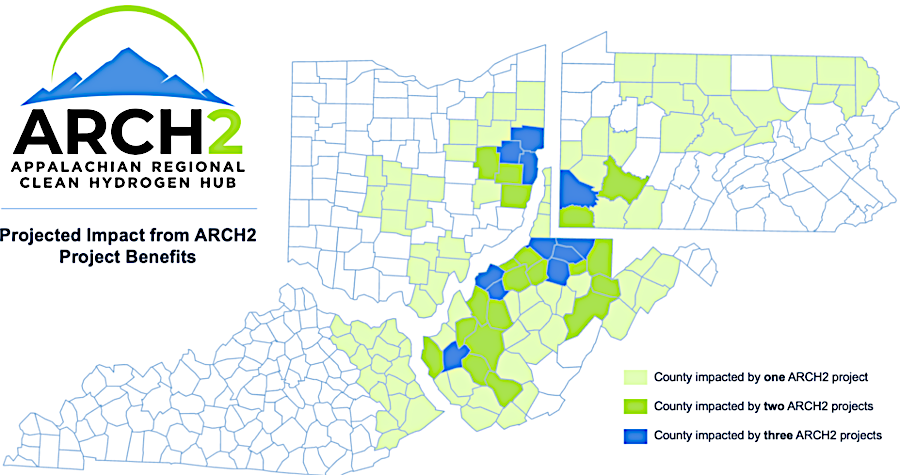
Dominion Energy was a member of the successful Appalachian Regional Clean Hydrogen Hub (ARCH2) bid in 2023 for Federal funding as a hydrogen hub
Source: Appalachian Regional Clean Hydrogen Hub (ARCH2), Why ARCH2
The steam methane reforming (SMR) process uses a "water gas shift reactor" to convert carbon monoxide and water into carbon dioxide and hydrogen (CO + H2O = CO2 + H2). A catalyst facilitates the shift of the hydrogen atom away from the oxygen atom in the water molecule.
Producing hydrogen from natural gas and releasing the CO2 into the atmosphere creates "gray" hydrogen with a carbon intensity close to 10kg CO2e/kg H2. If carbon capture and sequestration (CCS) are used to capture the CO2 to create "blue" hydrogen, the carbon intensity drops to 3.2kg CO2e/kg H2. If landfill gas is used as the feedstock instead of natural gas, the carbon intensity is less than 1kg CO2e/kg H2.
Gasification of a biomass feedstock can create hydrogen with a carbon intensity of 1.5 kg CO2e/kg H2. If water is the feedstock, electrolysis with electricity from renewable resources can produce hydrogen with a carbon intensity lower than 0.45kg CO2e/kg H2.
The Inflation Reduction Act (IRA) of 2022 provided funding for hydrogen projects with lifecycle emissions of less than 4kg CO2e/kg H2 produced. The Greenhouse gases, Regulated Emissions, and Energy use in Transportation (GREET) model was used to define the emissions generated through the whole lifecycle, including drilling, transport, production and use of the hydrogen. Section 45V of the Inflation Reduction Act defined four tiers of incentives:5
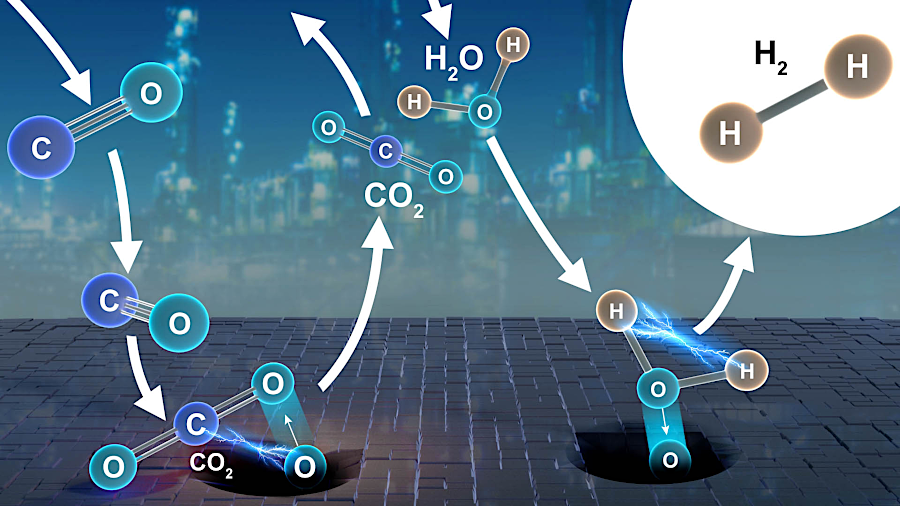
the steam methane reforming (SMR) process shifts hydrogen atoms away from oxygen atoms in a water molecule to create H2 and CO2
Source: US Department of Energy, Oak Ridge National Laboratory, Hydrogen Demand and Resource Analysis
Leaks of even "green" hydrogen could have a negative impact on climate change. The molecules extend the life of other greenhouse gases (GHGs) in the atmosphere, increasing their ability to generate global warming:6
Hydrogen does offer a way to store energy, comparable to a battery.
In 2022, the Federal government provided a $500 million loan to an Advanced Clean Energy Storage project in Utah. The project planned to create hydrogen by electrolysis of water, using excess electricity generated by wind and solar facilities during times of low demand. Instead of forcing curtailment of generation by solar and wind facilities to avoid overloading the electrical grid and forcing the frequency to exceed 60 hertz, the excess could be used to create up to 100 metric tons of hydrogen per day. Later, the hydrogen could be retrieved from underground salt domes when demand increased and burned in gas turbines.
When the hydrogen production was viewed on a dollars per kilogram basis, the project was not cost-effective. Creating "green" hydrogen by electrolysis of water would be significantly more expensive than using natural gas as the starting point. The process would require twice as much electricity to create the hydrogen as would be generated by later burning that hydrogen. Lithium-ion batteries could provide peak power for short periods at far lower cost than burning hydrogen.
The costs were justified because the project could balance out seasonal excesses and shortages of electricity. Excess electricity generated in the summer by wind and solar projects, which had no value at that time, could be used to produce hydrogen for seasonal energy storage. The investment was justified by the benefits of storing 300 gigawatt-hours of energy in the form of hydrogen.
As power plants based on fossil fuels were retired, the need increased for reliable sources of baseload electricity. When other forms of electricity generation were falling short due to low winds, cloudy weather, or winter, the value of stored electricity was much higher. While lithium-ion batteries were more efficient for short-term energy storage, hydrogen was projected to be the low-cost option for seasonal energy storage.
The project included replacing a coal-fired power plant with a power plant that was fueled by natural gas. Initially, all electricity at the Intermountain Power Agency site would be produced from burning natural gas. As hydrogen became available, it would be blended into the natural gas and become 30% of the mixture. By 2045, the plant was projected to burn 100% green hydrogen.7
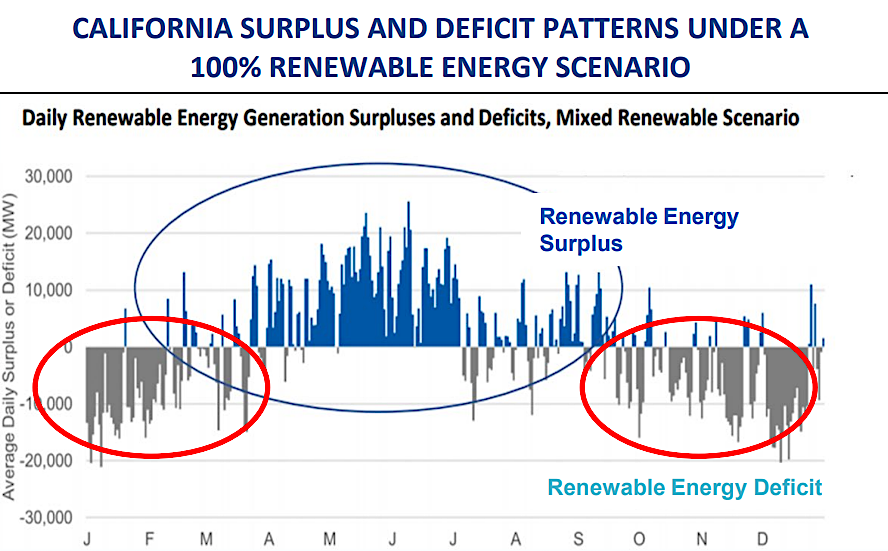
manufacturing and storing hydrogen addressed the seasonal imbalance between demand and electricity generation from renewable sources
Source: Los Angeles Department of Water and Power, Intermountain Power Project SITLA Board Meeting, February 17, 2022
Hydrogen also had the potential to replace gasoline and diesel used to power vehicles on highways. That vision required electrolyzing water to produce green hydrogen, plus the creation of hydrogen fueling stations to replace gas stations. In comparison to electricity-based vehicles, hydrogen is a very inefficient alternative:8
Source: Hydrogen: fuel of the future?
One possibility is for vehicles to use fuel cells to recombine the hydrogen and oxygen to produce electricity. In a fuel cell, hydrogen interacts with a catalyst at at a negatively-charged anode. The electrons and protons in the hydrogen molecule separate, with electrons flowing through a circuit to the positively-charged cathode and creating an electric current.
The protons flow through the electrolyte in the fuel cell that separates the anode and cathode. At the cathode, the protons combine with oxygen in the air and create water vapor. There is no combustion, and no carbon dioxide emissions.
Fuel cells are common in spacecraft, and the Apollo astronauts drank the water that was created as a byproduct. On the Apollo 13 mission, a tank in the Service Module with oxygen for the fuel cells ruptured. That required aborting the plan for those astronauts to land on the moon.
Aviation is one of the fastest-growing sources of greenhouse gases, contributing 2% of the total. Airplanes are being designed now to use combustion jet engines burning liquid hydrogen, and also operate with fuel cells generating electricity for electric motors that spin propellors. In 2023, a 19-seat plane successfully tested using fuel cells.
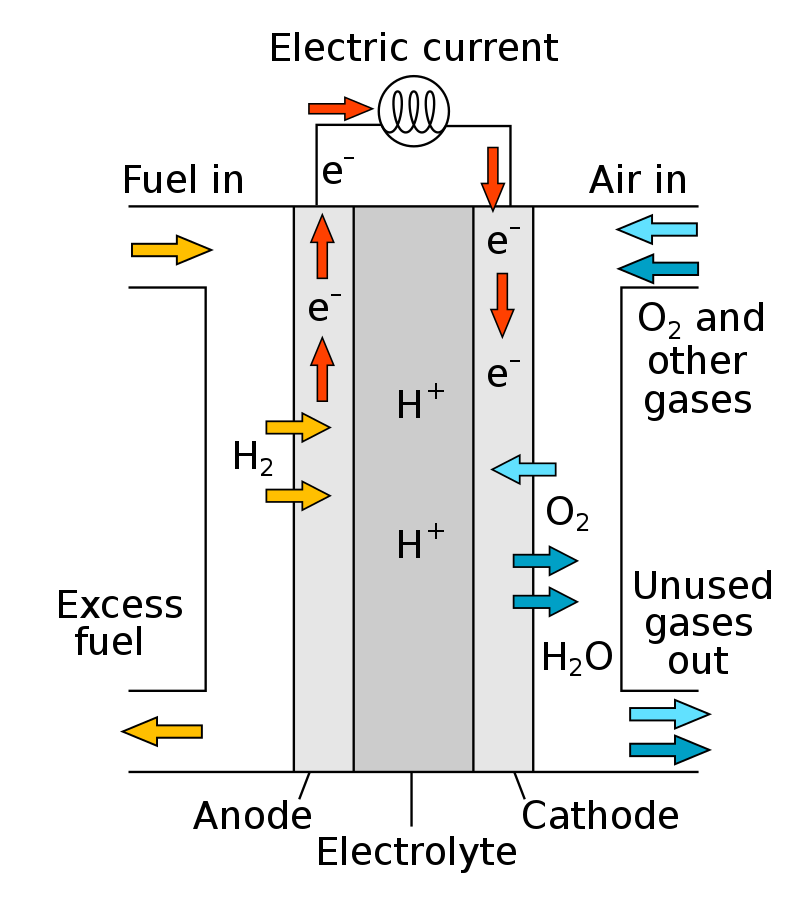
fuel cells convert H2 and O2 into H2O and electricity
Source: R. Dervisoglu, Fuel Cell
Cars and trucks using fuel cells would require multiple fueling stations along the highways to resupply hydrogen. In 2022, there were no hydrogen fueling stations for airplanes or other vehicles in Virginia.9

in 2022, the only hydrogen fueling stations in North America were in California and Canada
Source: US Department of Energy, Hydrogen Fueling Station Locations
One steady user of hydrogen is the National Weather Service. Every day at 6:00am and again at 6:00pm (or 7:00am/pm during Daylight Savings Time), meteorologists fill latex balloons with enough hydrogen to expand the balloon to about five feet in diameter. They attach a light (three ounce) radiosonde at the end of a tether about 100 feet in length, and launch it to measure local temperature, humidity and air pressure. Hydrogen is a cheaper gas for getting the balloon to rise in the air compared to helium.
As the balloon rises, it expands. Once it reaches a diameter of 20 to 25 feet, the balloon pops. The latex balloons and string tethers are biodegradable.
The radiosonde descends on a parachute. The devices were once expensive enough to justify having a mailer attached, so anyone who found a radiosonde might send it back to the National Weather Service. Today, the devices and balloons are considered disposable.10


weather balloons are filled with hydrogen twice a day to launch radiosondes that measure temperature, humidity and air pressure
Source: National Weather Service, Collecting Meteorological Data by Radiosonde or Weather Balloon
A future possibility is use of hydrogen to replace diesel-powered backup generators at data centers, refrigerated warehouses, etc. Linear generators use low-temperature reactions with 100% ammonia or hydrogen to generate electricity without combustion, offering a low-carbon or low or no-carbon alternative to traditional backup power generators. The generation process relies upon the controlled expansion of reacted gases, converting linear motion directly into electricity.
Existing linear generators fueled by natural gas or biogas could be converted to hydrogen, once it becomes available. For companies with a commitment to eliminating carbon emissions, a long-term investment in linear generators can be more cost-effective if there is a plan to switch to hydrogen.11
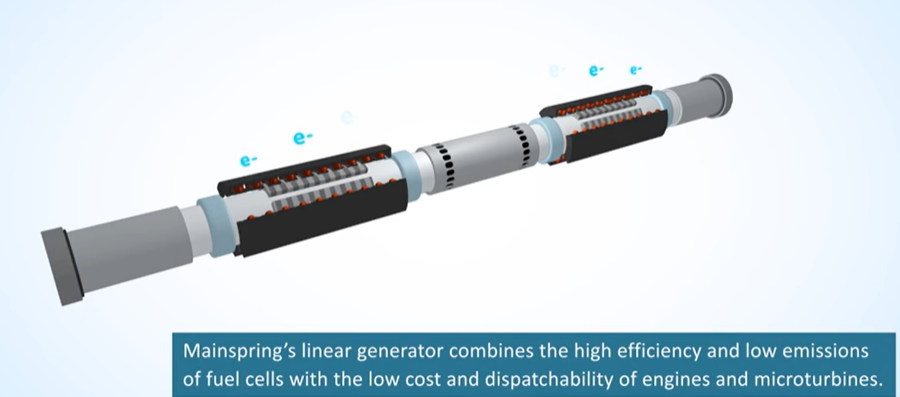
linear generators directly convert linear motion into electricity, without combustion or its byproducts
Source: Mainspring, Technology Overview
The first hydrogen project in Virginia was a proposal by Chickahominy Power to build a 1,600 megawatt natural gas power plant in Charles City County to generate electricity. The company suggested that plant could convert to using "blue" hydrogen at a later date. The controversial project required construction of a new pipeline to deliver natural gas. In 2022, plans for the pipeline and the power plant were abandoned.12
The next proposal was for construction of a data center campus, with a water treatment plant and a hydrogen production facility, surrounding the site of the Birchwood Power Plant in King George County.
That coal-fired power plant closed in 2021, and two companies initially cooperated in redevelopment plans. The 211-acre site of the power plant had been rezoned in 1991 from agricultural use to authorize just the power plant, and the county was asked to rezone 700 additional acres to allow a wide range of industrial uses.
The initial proposal was to install solar panels and battery storage to create a "carbon free solar and energy storage facility.," but local planners complained that the official requests failed to identify the specific planned industrial uses. Green Energy Ventures then ended its partnership with J-Power USA, which owned the former power plant. Green Energy Ventures had agreements with four landowners to develop 230 acres surrounding the power plant.
That company proposed a rezoning to allow construction of data centers, a hydrogen production facility, and the water treatment plant. There was water in the Rappahannock River which could be converted into green hydrogen, but there was no natural gas pipeline in King George County that could supply fuel for blue hydrogen.13
At the 100-acre Tech Center Research Park in Newport News, with room for nearly 1 million square feet of office and laboratory space as well as a retail center and nearly 300 residential units, a coalition launched a $6.5 million green hydrogen fuel program in 2023. Members of the coalition included the Virginia Tech Corporate Research Center, Hampton Roads Alliance and the cities of Newport News, Norfolk, Portsmouth and Virginia Beach. The plan was to create demonstration projects that used green electricity, generated from the Coastal Virginia Offshore Wind turbines, to create hydrogen that powered vessels and trucks used in maritime and port operations.
The site was included in the Mid-Atlantic Hydrogen Hub proposal, but that was not selected to to be one of the seven "hydrogen hubs" receiving $7 billion in funding from the U.S. Department of Energy. The partners stil managed to assemble $6.5 million to establish a hydrogen test facility and demonstration site, including a fueling station in the Tech Center Research Park.
The focus was on using hydrogen to replace natural gas in electricity generation station and to power heavy machinery, and not as a new fuel for cars. The Virginia Tech Corporate Research Center president said in 2024:14

the Tech Center Research Park in Newport News planned to generate green hydrogen to power vessels and trucks used in maritime and port operations
Source: ESRI, ArcGIS Online
In 2025, a Petersburg company began to capture hydrogen that was being released as a waste product from a factory producing bleach for water and wastewater treatment plants. Initially the hydrogen was sold to Walmart for use in fuel cells, but there was potential to blend it into natural gas in a nearby pipeline. Independence Hydrogen paid for what was otherwise a useless by-product, saying to the bleach producer:15
Utilities could extend the life of power plants fueled now by natural gas by blending in hydrogen, reducing greenhouse gas emissions. In 2023 Florida Power & Light began using a 25-megawatt solar facility to split water molecules in order to create hydrogen and add it to the fuel mixture at an electricity generating plant.
However, a major problem with using green hydrogen to generate electricity is inefficiency. The power-to-hydrogen-to-power process involves loss of energy in the electrolysis process and in burning hydrogen to spin a generator, so in the end only only 20-50% of the energy is converted into electricity.
Environmental groups seek to limit tax credits for hydrogen under the Inflation Reduction Act to more cost-effective applications such as making steel, energy storage, and fuel for transportation. Companies producing petrochemicals, cement and steel are top candidates for using hydrogen to decarbonize manufacturing processes.16
A shift to hydrogen would be most beneficial if it was produced through a process that displaced fossil fuels. "Green" hydrogen, not just any form of hydrogen, was needed in order to reduce greenhouse gas emissions.
The criteria proposed by the Biden Administration in 2023 for hydrogen projects to qualify for Federal subsidies incorporated all three "pillars" proposed by the environmental community. Producers could not just buy Renewable Energy Certificates (REC's) and qualify for tax credits. Instead:17

the nearest source of natural gas for a potential blue hydrogen production plant in King George County (red X) were pipelines (blue lines) in Spotsylvania County
Source: US Department of Transportation, National Pipeline Mapping System, Public Viewer

Virginia had few proposed hydrogen refueling stations along major interstates
Source: US Department of Energy, National Renewable Energy Laboratory (NREL), Hydrogen Resource Data, Tools, and Maps